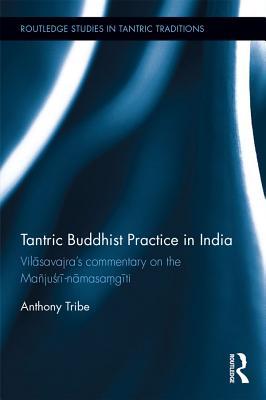Read online Tantric Buddhist Practice in India: Vilāsavajra's Commentary on the Ma�juśrī-Nāmasaṃgīti - Anthony Tribe file in PDF
Related searches:
Tantric Buddhist Practice in India: Vilasavajra s commentary on the
Tantric Buddhist Practice in India: Vilāsavajra's Commentary on the Ma�juśrī-Nāmasaṃgīti
Tantric Buddhist Practice in India: Vilasavajra?s commentary on the
Tantra and the Tantric Traditions of Hinduism and Buddhism Oxford
Tantric Buddhist Practice in India: Vilāsavajra's commentary on the
The Tantric Age: a comparison of Shaiva and Buddhist Tantra by
Indian Esoteric Buddhism: A Social History of the Tantric Movement
The Myths, Challenges, and Rewards of Buddhist Tantra - Lion's Roar
Sex, Misogyny and Female Inclusion in Tantric Buddhism The
Jan 29, 2017 india-yoga-religion buddhist practices, texts, and deities indeed exerted a strong influence in the shaping of extensively on extreme practices in yoga and written a book on the esoteric tantric practice of khecha.
Modern tantric jargon is derived from a variety of classical hindu and buddhist sources. Day india, the term tantra is often associated with sleazy massage parlours, tantriks promising miracle.
May 13, 2016 for one thing, the vajrayana has been intensely practice-oriented, and it in india, tantric saints were often persecuted; in tibet they were.
Making sense of tantric buddhism fundamentally rethinks the nature of the transgressive theories and practices of the buddhist tantric traditions, challengin. History, semiology, and transgression in the indian traditions.
Tantric sex is the most modern known form of tantra, probably due to the exciting nature of the topic and the media’s interest in the sexual angle. It includes many of the ancient indian and buddhist teachings of cosmic connection but it also combines it with modern sexual ideologies.
Jun 3, 2016 the book contributes to our understanding of the history of indian tantric buddhism in a period of significant change and innovation.
Tantric buddhist practice in india: vilāsavajra's commentary on the mañjuśrī- nāmasaṃgīti (routledge studies in tantric traditions) - kindle edition by tribe,.
Jan 14, 2004 it was brought from india at the invitation of the tibetan king, trisong tibetan buddhist practice features a number of rituals, and spiritual.
Tantra denotes the esoteric traditions of hinduism and dangerous and impure supernatural realm from the indian perspective.
Although indian and tibetan versions of tantric buddhism are increasingly recognized, the east asian variations on this practice remain largely overlooked. The only book to present the entire breadth of tantric buddhism in east asia, this collection remedies that situation with 12 key essays drawn from rare sources.
More than 1,000 years ago, the yogis of bengal and orissa in india developed this spiritual art, and a few still practice it in an underground fashion, as do the tantric yogis and lamas of tibetan.
Com: tantric buddhist practice in india: vilāsavajra's commentary on the mañjuśrī-nāmasaṃgīti (routledge studies in tantric traditions).
Finally, and still within the tibetan component, the course will examine the role of the yogic traditions in tibetan religious culture, from inception to the 15th century,.
using a commentary on the influential text, the mañjuśrī-nāmasaṃgīti, ‘the chanting of the names of mañjuśrī’, this book deals with buddhist tantric meditation practice and its doctrinal context in early-medieval india. The commentary was written by the 8th-9th century indian tantric scholar vilāsav.
Apr 5, 2016 tantric hindu and buddhist traditions were also a significant influence heavily dependent on earlier indian traditions of thought and practice.
These tantric temples represent an age-old custom which upholds the feminine power. Interestingly, the tantric practices had an integral role to play in buddhism as well. Today, these practices are mainly followed in some shakti peethas across india.
Tantric buddhism is associated with groups of wandering yogis called mahasiddhas in medieval india.
Indian esoteric buddhism: a social history of the tantric movement. 2 prayers in the palace, swords in the temple: early medieval india.
Tantric buddhism or vajrayana in sanskrit (meaning “thunderbolt” or “diamond vehicle”) is a complex and understudied part of the buddhist tradition that is of considerable importance to the history of buddhism and indo-tibetan cultural relations. The term ‘tantric buddhism’ is applied to a type of buddhist practice where tantra.
Tantric buddhist practice in india: vilāsavajra’s commentary on the mañjuśrī-nāmasaṃgīti (routledge studies in tantric traditions) - kindle edition by tribe, anthony. Download it once and read it on your kindle device, pc, phones or tablets.
Anthony tribe is an independent scholar with a research specialization in the history and development of tantric buddhism in india. He is the co-author of buddhist thought: a complete introduction to the indian tradition (2012), also published by routledge.
It is in my view certainly indian tantric buddhist texts that form the most in general repeated practice of tantric meditation that brought about liber- ation.
Tantric buddhist practice in india: vilāsavajra's commentary on the mañjuśrī- nāmasaṃgīti (routledge studies in tantric traditions) ebook: tribe, anthony:.
The main thesis of this paper is that in the medieval period, tantric buddhism is� an indian interreligious movement driven by a ritual practice presupposing.
Buddhist tantric practice is categorized as secret practice; this is to avoid misinformed people from harmfully misusing the practices. A method to keep this secrecy is that tantric initiation is required from a master before any instructions can be received about the actual practice.
Using a commentary on the influential text, the mañjuśrī-nāmasaṃgīti, ‘the chanting of the names of mañjuśrī’, this book deals with buddhist tantric meditation practice and its doctrinal context in early-medieval india.
Dec 14, 2019 the book contributes to our understanding of the history of indian tantric buddhism in a period of significant change and innovation.
Tibet too has a very strong buddhist tantric background which continues, albeit many have been transplanted to monasteries in india, and claims to be a right-hand path, in contrast to the more varied hindu counterparts (that include both left and right-hand practices).
Tantric practice involves various stages, some that make use of elaborate rituals and visualizations. One begins by visualizing chenrezig as a figure made of light above one’s head.

Post Your Comments: